Khasi Festivals and Dances
FESTIVALS
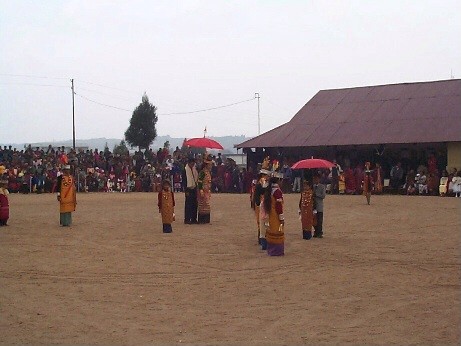
SHAD SUK MYNSIEM:
Dance of the joyful heart, it is a thanksgiving dance celebrated usually in
April. It is an important festival of the Khasis, held at Weiking.
This dance is popularly known as Shad Weiking and celebrated for three
days. On the first day, male dancers gather at Seng Khasi Hall and
together in procession walk to Weiking accompanied by drums and flutes, this
dance on the first day is known as the Shad Nohkjat. In the evening the
dancers return to the Seng Khasi Hall, located at Mawkhar, to resume dancing
outside the hall. The third day is the biggest day, dancers flock the
ground, bejeweled girls attired in traditional finery and silver clad men in
colourful costumes dance to the beating of drums and accompaniment of
flutes. People from all walks of life come to the ground in their
traditional dresses. During these three days male dancers return back from
the ground in procession along with drummers and flutist to resume dancing
display outside the Seng Khasi Hall for an hour or so.
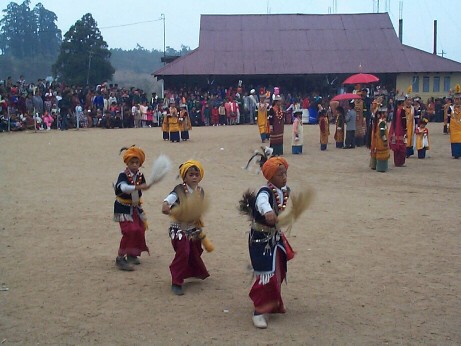 NONGKREM DANCE: This
festival is performed at Smit village. The festival is essentially a
commemoration when the evolutionary process of Khasi matured into the formation
of democratic states. The legendary Shillong Peak stands testimony to this
episode, when the Creator in divine congregation manifested in the person of 'U
Shyllong' and bestowed the art of democratic governance and the rule of
justice. Pah Syntiew was ordained to pro-generate the linage of elected
rulers (Syiems) on the formation of Shyllong State (HIMA). The Hima
shyllong was later bifurcated into Hima Khyrim and Hima Mylliem, the
Headquarter of Hima Khyrim was then shifted from Nongkrem to Smit in 1830.
For three consecutive nights (Pamtiah, Umni, Ieduh) solemn reverence and
obeisance is paid to U Lei Shyllong (the creator as conceived in the person of U
Shyllong), U Suid Nia Long Syiem (the ancestral maternal uncles) and to
the venerated progenitress ancestress "Ka Pah Syntiew" of the
ruling lineage. A sanctification ceremony of the Tangmuri, as queen of the
musical instruments, form part of the ritual. exegesis is also made
on the entrails of fowls and decapitated goats presented by each Raid (Zilla) of
the Hima. A separate ceremony is performed on the third day being the
Iewduh market of the week. On the fourth day, virgins and youths attired
in traditional dresses, dance in the courtyard of the Iingsad, on the fith and
last day, amid pin drop silence of midnight, the Syiem knells down and offers a
prayer of thanks giving to the Creator.
NONGKREM DANCE: This
festival is performed at Smit village. The festival is essentially a
commemoration when the evolutionary process of Khasi matured into the formation
of democratic states. The legendary Shillong Peak stands testimony to this
episode, when the Creator in divine congregation manifested in the person of 'U
Shyllong' and bestowed the art of democratic governance and the rule of
justice. Pah Syntiew was ordained to pro-generate the linage of elected
rulers (Syiems) on the formation of Shyllong State (HIMA). The Hima
shyllong was later bifurcated into Hima Khyrim and Hima Mylliem, the
Headquarter of Hima Khyrim was then shifted from Nongkrem to Smit in 1830.
For three consecutive nights (Pamtiah, Umni, Ieduh) solemn reverence and
obeisance is paid to U Lei Shyllong (the creator as conceived in the person of U
Shyllong), U Suid Nia Long Syiem (the ancestral maternal uncles) and to
the venerated progenitress ancestress "Ka Pah Syntiew" of the
ruling lineage. A sanctification ceremony of the Tangmuri, as queen of the
musical instruments, form part of the ritual. exegesis is also made
on the entrails of fowls and decapitated goats presented by each Raid (Zilla) of
the Hima. A separate ceremony is performed on the third day being the
Iewduh market of the week. On the fourth day, virgins and youths attired
in traditional dresses, dance in the courtyard of the Iingsad, on the fith and
last day, amid pin drop silence of midnight, the Syiem knells down and offers a
prayer of thanks giving to the Creator.
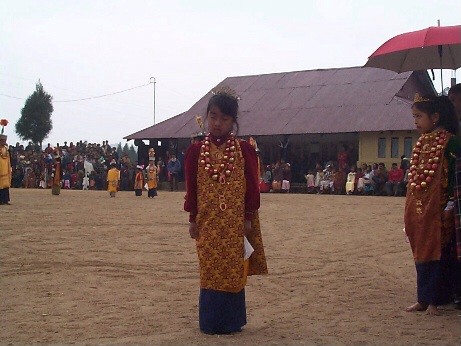 BEHDEINKHLAM: a colourful
and majestic event celebrated in the month of July to ensure that the crops just
sown yield a bountiful harvest. The actual festival runs for four days,
featuring religious ceremonies, processions, dancing (usually in the rain) and
an ancient game akin to soccer but played with a wooden ball, known as "Datlawakor".
It is also the most important festival of the Jaintia. Khlam
means plague or pestilence and Behdein means to drive away with
sticks. It is very popular and colourful, where men only, young or
old take part in the dancing to the tune of the drums and flute. Women do
not take part in the dancing but, have an important role to play at home in
offering sacrificial food to the spirit of the ancestors. They evoke their
aid and intersection, so that life will be good and worthy. Men go
round the town and beat the roof of every house with bamboo poles calling upon
the plague demon to leave the house. This is done early on the first day
of the festival. The climax of the celebrations is the tussle, akin to
tug-of-war, for a large undressed beam by two groups of people opposed to each
other. The festival is also an invocation to God seeking his blessing for
a good harvest. The soccer game with a wooden ball, known as Datwakor, is
performed on the last day of the festival, at Aitnar, Jowai. Beautiful
three or four storeyed Tabuts (Pyramidical topping shape) are displayed in the
dancing ground, brought from every nook and corner of Meghalaya is a real treat
to the eyes. These tabuts resemble the Muharram festival of the
Muslims. The Behdeinkhlam festival celebrated at Tuber is considered to be
the biggest and grandest.
BEHDEINKHLAM: a colourful
and majestic event celebrated in the month of July to ensure that the crops just
sown yield a bountiful harvest. The actual festival runs for four days,
featuring religious ceremonies, processions, dancing (usually in the rain) and
an ancient game akin to soccer but played with a wooden ball, known as "Datlawakor".
It is also the most important festival of the Jaintia. Khlam
means plague or pestilence and Behdein means to drive away with
sticks. It is very popular and colourful, where men only, young or
old take part in the dancing to the tune of the drums and flute. Women do
not take part in the dancing but, have an important role to play at home in
offering sacrificial food to the spirit of the ancestors. They evoke their
aid and intersection, so that life will be good and worthy. Men go
round the town and beat the roof of every house with bamboo poles calling upon
the plague demon to leave the house. This is done early on the first day
of the festival. The climax of the celebrations is the tussle, akin to
tug-of-war, for a large undressed beam by two groups of people opposed to each
other. The festival is also an invocation to God seeking his blessing for
a good harvest. The soccer game with a wooden ball, known as Datwakor, is
performed on the last day of the festival, at Aitnar, Jowai. Beautiful
three or four storeyed Tabuts (Pyramidical topping shape) are displayed in the
dancing ground, brought from every nook and corner of Meghalaya is a real treat
to the eyes. These tabuts resemble the Muharram festival of the
Muslims. The Behdeinkhlam festival celebrated at Tuber is considered to be
the biggest and grandest.
DANCES
Dances locally means Ki Shad. There are two types of dances, that
is ka Shad Niam (Ceremonial Dance) and Ka Shad Rong (Merriment Dance).
KA SHAD LEHNIAM IEWDUH: Performed annually at Iewduh (Barabazar)
by the Mylliem Syiemship, to propitiate the market deity for a blessed and
peaceful trade. Goat sacrifice is part of the religious ceremony.
When the ceremony is over, dancers started dancing to the accompaniment of drums
and flute.
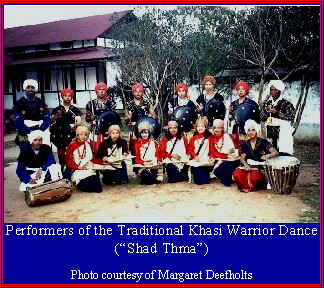 KA SHAD NGUH 'LEI SHYLLONG': Ceremonial dance performed annually
at the top of Shillong Peak by Mylliem Syiemship, praying for bountiful rain,
good health, etc. A White goat is sacrificed to the Creator. The
moment the head is severed from the body at a single chop, they dance joyfully
especially after they have examined the signs as indicated by the Creator.
If the sign is good then they become more cheerful and dance robustly.
KA SHAD NGUH 'LEI SHYLLONG': Ceremonial dance performed annually
at the top of Shillong Peak by Mylliem Syiemship, praying for bountiful rain,
good health, etc. A White goat is sacrificed to the Creator. The
moment the head is severed from the body at a single chop, they dance joyfully
especially after they have examined the signs as indicated by the Creator.
If the sign is good then they become more cheerful and dance robustly.
KA SHAD NGUH LYNGDOH: Ceremonial dance performed
annually by the Mylliem Syiemship at Mawnarian and Iewduh celebrating Ka Lehniam
Iewduh and part of conclusion of religious ceremony at Mawnarian, interlinked
directly with Ka Shad Nguh 'Lei Shyllong'.
KA SHAD INGLONG KARDOM: Ceremonial dance of Knia Rynkew
performed by Raid Umwang to propitiate the deity who guards them. Other
dances performed by this Raid Umwang are Ka Shad Kokklor Ki Shon (Shad siej or
bamboo dance), Shad Rynkang Wait Rynkang Stieh, Shad Dait Khla Dait Masi,
Shad Sangkirip (shad kyrkhu iing), Shad Snieh Khla, Shad Soi Kba, Bam ja Khaw
Thymmai, Shad Prat Rinong (pynkhuid Khyrdop) and Ka Shad Nguh. Raid Umwang
is located at Karbi Anglaong which falls under the jurisdiction of Mylliem
Syiemship.
KA SHAD NGUH MEIKHA BAD PHUR PEPBAH: Ceremonial dances in
connection with post funeral rites performed by different villages, like ka shad
Phur of Nongjri, Khat-ar Shnong, Mawkyrwat, Maharam, etc. Ka Shad Nguh
Meikha and Phur Pepbah of Nongtung, etc. Other ceremonial dances include
Ka Shad Lyngdoh of Wahkhen, Shad Thang Syiem And Thung Syiem of Sohra and
Nongkhlaw, both prestigious ceremonial dances belong to religious rites, the
former for cremation and the latter for anointment.
KA SHAD SAJER: Ceremonial dance held annually at Nongbah
(Raid Nongpoh) by Ka Seng Pynneh Riti Khat-ar Lyngdoh. Usually held in the
last part of January. neighboring zillas (raids) also come to take part in
this dance. Shad Sajer is more or less like a festival of the Ri-bhoi
District. Other dances include Ka Shad Shohkba of Raid Nongkharai, Shad
Shutwait and Shad Dongdong, Shad Malangho and Shad Kynjuh Kynthei of Raid
Nonglyngdoh. Shad Puh Lyngkha of Raid Sohkhwai, Shad Shutwait and Kynjuh
Kynthei of Raid Nongkhrah.
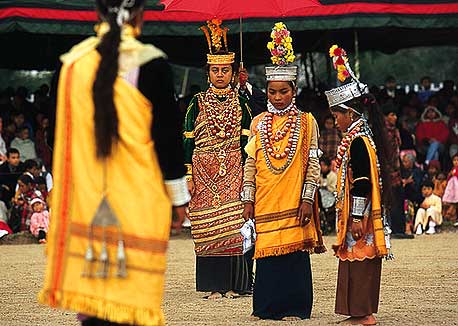 KA SHAD LARNIUH: Ceremonial dance of Nartiang, under
Jaintia Hills District. This dance is performed during the grandest
festival, ka Knia Blai Iaw Nartiang. Defunct for the last 41 years and
revived on 26th April 1997, propitiating the Market Deity.
KA SHAD LARNIUH: Ceremonial dance of Nartiang, under
Jaintia Hills District. This dance is performed during the grandest
festival, ka Knia Blai Iaw Nartiang. Defunct for the last 41 years and
revived on 26th April 1997, propitiating the Market Deity.
KA SHAD RONGKHLA: Ceremonial dance of the
Nongtalang, Jaintia Hills District. It is usually performed when they catch a
tiger.
KA SHAD NIAM BUHSHYIENG: Ceremonial dance of the Lamin.
KA SHAD RONGSYNRIANG: Ceremonial dance of the Nongbareh.
KA SHAD THANG SHYIENG: Ceremonial dance of the Nongbareh
performed only once in a century.
KA SHAD POMBLANG IAWMUSIANG: Ceremonial dance of the
Nongbah.
KA SHAD KNIA KOPATI: Ceremonial dance of Raliang.
KA SHAD POMBLANG 12 NOR:
Ceremonial dance of the Shangpung.
KA SHAD KERAI IONPRAI: Ceremonial dance of the
Nongtalang.
KA SHAD LEHDARI: War dance of the
Nobosohphoh Syiemship, West Khasi Hills District.
KA SHAD BEHDEINKHLAM: Festive dance of Jowai, Chyrmang, Tuber,
Ialong, Muthlong, Sohkynphor and Mukhla. (Jaintia Hills District)
KA SHAD LEIT SHAW KURIM: Dancing in joyful spirit of
Riangsih Syiemship in connection with marriages. (West Khasi Hills
District)
KA SHAD KRUD KSING: Meriment
dance performed by Raid Thaiang of Ri Bhoi District.
KA SHAD MIET: Merriment dance of the Lyndem (Ri War) East
Khasi Hills District, where bother sexes dance together.
KA SHAD NOHSAKYRIAT: Merriment dance of the IALONG,
Jaintia Hill District.